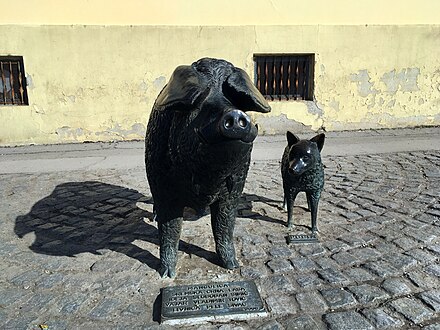Syrmia - geographical region of the Pannonian Plain
Syrmia is a historical region of Southeastern Europe, located in the southernmost part of the Pannonian Basin, and shared by Croatia and Serbia. Being bounded mostly by natural features, it is also a geographical region, situated between the river Danube to the north and the east, river Sava to the south—up to the point where it discharges into the Danube—and river Bosut to the west, including certain areas to the south and west of Bosut; many view Syrmia as extending significantly further to the west (up to the western administrative border of the modern Vukovar-Syrmia County in Croatia).
Its Serbo-Croatian name is Srem/Srijem (depending on the local pronunciation—the former variant is common in Serbia and the latter in Croatia).
Syrmia is well known for its food and folk music.
Cities
<mapframe latitude="44.977428" longitude="19.477386" zoom="8" width="320" height="200" align="right" />In Croatia
Cities and towns in the Croatian part of Syrmia include:
- Vukovar
- Vinkovci
- Županja
- Ilok
- Otok
In Serbia
Cities and towns in the Serbian part of Syrmia include:
- Parts of Belgrade (Zemun and New Belgrade)
- Parts of Novi Sad (Petrovaradin and Sremska Kamenica)
- Sremska Mitrovica
- Ruma
- Inđija
- Stara Pazova
- Šid
- Irig
- Beočin
- Sremski Karlovci
Other destinations
- Fruška gora (mountain)
- Obedska bara (nature reserve)
- River Sava
- River Danube
Understand
Two thirds of its territory belongs to Serbia and the rest belongs to Croatia. This division was set and borders were drawn by the Yugoslav communist authorities, according to the national structure of the population. The Serbian part of Syrmia is located mostly in the Srem district (Sremski okrug), which is the southwestern district of the Vojvodina autonomous province. However, a defining, easternmost portion of Syrmia is contained within the administrative boundaries of Belgrade. Due to Syrmia having a strong historical continuity, and its geographical distinctness, many of the modern Syrmians (Sremci/Srijemci) have a pronounced regional identity. This is often told to, and noted by, visitors to Belgrade when they enter the historical town of Zemun (now completely surrounded by modern built-up areas), whose residents cling to their Syrmian roots. The Croatian part of Syrmia is located entirely within (or corresponds to) the Vukovar-Syrmia County (Vukovarsko-srijemska županija), which is the easternmost county within Slavonia, a wider-encompassing historical region of Croatia. This means that Slavonian and Syrmian regional identities in Croatia essentially overlap; however, a stereotypical Syrmian would be quoted as saying that they are "not Slavonian but Syrmian".
Syrmia had roughly one million inhabitants according to the Serbian 2002 census and the Croatian 2001 census.
The name Syrmia has origins in the name of Sirmium, an imperial city and one of four capitals of the Roman Empire (now Sremska Mitrovica, the largest city that lies entirely in this region).
Get in
By plane
- Airport Belgrade is located in Srem (Surčin)
By car or bus
- Highway E70 (Belgrade - Zagreb, former Autoput Bratstva i jedinstva)
- Highway Belgrade - Novi Sad
By train
- Belgrade - Zagreb and Belgrade - Novi Sad railways go through Srem
Get around
See
Do
Enjoy the region's lakes.
Eat
 Pork products define the region's cuisine. Sremski kulen (in Croatia: Slavonski kulen), a dried (or partially-dried) sausage, flavored with red paprika, is a locally prized food.
Pork products define the region's cuisine. Sremski kulen (in Croatia: Slavonski kulen), a dried (or partially-dried) sausage, flavored with red paprika, is a locally prized food.
Drink
There are wineries in the region.
Go next
- North:
- East: Belgrade
- South:
- Serbia: Podrinje, with the city of Šabac lying very close
- Bosnia and Herzegovina: Northeastern Bosnia (with the major city of Bijelijna nearby) and Posavina
- West: southern parts of Eastern Slavonia, with Slavonski Brod as a major border town
INDEX
Syrmia
Timezone:MultipleCoordinates:45.17, 19.29